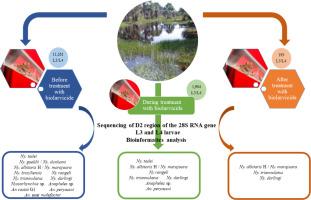鱼塘按蚊幼虫的DNA元条形码批量鉴定。
IF 2.5
3区 医学
Q2 PARASITOLOGY
引用次数: 0
摘要
水产养殖可导致亚马逊流域各地疟疾流行环境中疟疾病媒数量的增加。准确识别养鱼池孳生的按蚊幼虫对通过昆虫学监测实施有效的防蚊措施至关重要。在使用杀虫剂干预之前、期间和之后,制定了一项在物种水平上对鱼塘中存在的按蚊幼虫进行大量分子鉴定的方案。从14994只第三(L3)和第四(L4)龄幼虫中提取DNA,分为161个池。在每个幼虫池中扩增28S RNA基因D2区。对1357个扩增子序列变异(Amplicon Sequence variant, asv)进行了分类鉴定。其中,albitarsis H / marajoa Nyssorhynchus(7.60%)、巴西Nyssorhynchus(0.53%)、goeldii Nyssorhynchus / dunhami Nyssorhynchus(0.53%)、costai按蚊G1(0.08%)、near malefactor按蚊(0.46%)、tadei Nyssorhynchus(0.46%)、peryassui按蚊(34.07%)、rangeli nyshachus(11.79%)、darlingi nsohynchus(15.36%)和triannulnsohynchus(29.12%)被划分为1315种asv。42种asv无法达到种水平的鉴定。采用木村2参数距离计算D2区种间遗传距离,范围为0% ~ 24.93%。上述所有蚊种均在施用杀虫剂前于鱼塘内发现。治疗期间,nyyssorhynchus sp., Ny。goeldii / Nydunhami,纽约。braziliensis,。costai G1和An。近恶性因子未被收集。在治疗后的时间里,只有Ny。嗜酒性肝病marajoara,纽约。triannulatus和Ny。达林吉被发现了。本文介绍了一种按蚊幼虫的分子体鉴定方法,该方法有望在幼虫控制过程中进行昆虫学监测。本文章由计算机程序翻译,如有差异,请以英文原文为准。

Bulk identification of Anophelinae larvae from fishponds using DNA metabarcoding
Aquaculture can contribute to the increased abundance of malaria vectors in endemic settings across the Amazon Basin. Accurate identification of anopheline larvae breeding in fish-farming ponds is essential for the effectiveness of mosquito control interventions through entomological surveillance. A protocol was developed for bulk molecular identification, at the species level, of anopheline larvae present in fishponds before, during, and after an intervention with biolarvicides. DNA was extracted from total 14,994 third (L3) and fourth (L4) larval instar stages, grouped into 161 pools. The D2 region of the 28S RNA gene was amplified in each larvae pool. Taxonomic assignment was performed for 1,357 Amplicon Sequence Variants (ASVs). The following species were assigned to 1,315 ASVs: Nyssorhynchus albitarsis H / Nyssorhynchus marajoara (7.60%), Nyssorhynchus braziliensis (0.53%), Nyssorhynchus goeldii / Nyssorhynchus dunhami (0.53%), Anopheles costai G1 (0.08%), Anopheles near malefactor (0.46%), Nyssorhynchus tadei (0.46%), Anopheles peryassui (34.07%), Nyssorhynchus rangeli (11.79%), Nyssorhynchus darlingi (15.36%), and Nyssorhynchus triannulatus (29.12%). Identification to species level was not possible for 42 ASVs. These ASVs were designated as Nyssorhynchus sp. and Anopheles sp. Interspecific genetic distances of the D2 region were calculated using the Kimura 2-parameter distance and ranged from 0% to 24.93%. All mosquito species mentioned above were found in fishponds prior to the application of biolarvicide. During treatment, Nyssorhynchus sp., Ny. goeldii / Ny. dunhami, Ny. braziliensis, An. costai G1, and An. near malefactor were not collected. In the post-treatment period, only Ny. albitarsis H / Ny. marajoara, Ny. triannulatus, and Ny. darlingi were found. Here a protocol for bulk molecular identification of anopheline larvae is described and it can be promising to entomological surveillance during larval control.
求助全文
通过发布文献求助,成功后即可免费获取论文全文。
去求助
来源期刊

Acta tropica
医学-寄生虫学
CiteScore
5.40
自引率
11.10%
发文量
383
审稿时长
37 days
期刊介绍:
Acta Tropica, is an international journal on infectious diseases that covers public health sciences and biomedical research with particular emphasis on topics relevant to human and animal health in the tropics and the subtropics.
 求助内容:
求助内容: 应助结果提醒方式:
应助结果提醒方式:


